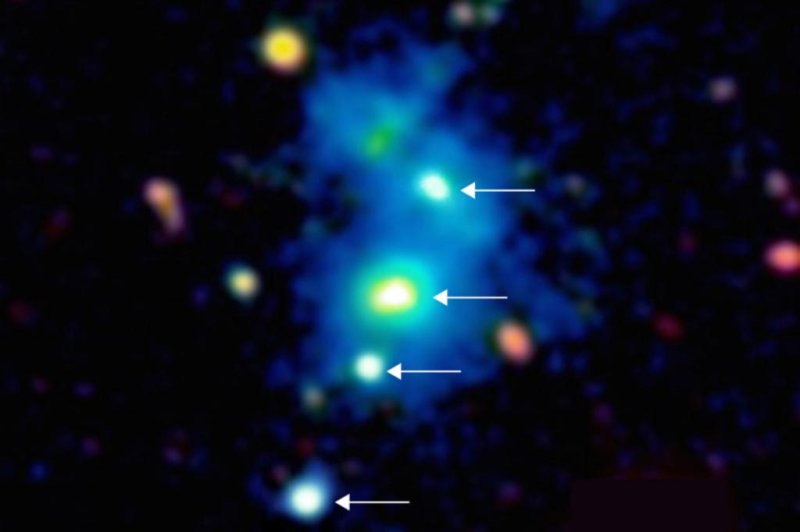Four quasars, all in a row. Photo by Joseph Hennawi/Fabrizio Arrigoni-Battaia
SANTA CRUZ, Calif., May 15 (UPI) -- Quasars -- the bursts of glowing gas that surround black holes as they swallow everything around them -- aren't usually found right next to each other. But researchers recently found four in a row, a quasar quartet.
The glow of the four quasars and their brightly enflamed gas, red and orange as it's sucked into the black hole's accretion disc, are bright enough to light a massive expanse of deep space -- an area one million light-years across, dubbed the Jackpot nebula.
Astronomers say the Jackpot nebula -- which is delivering light that's been traveling for 10 billion years -- is one of the most massive and dense structures ever discovered in the distant universe. Its size and structure more closely resemble the regions of galactic amalgamation in the modern universe, like the Milky Way's neighbors.
"There are several hundred times more galaxies in this region than you would expect to see at these distances," principle investigator J. Xavier Prochaska, a professor at the University of California Santa Cruz, explained in a press release.
The astronomers located the four quasars and their sizable home using telescopes at the Keck Observatory.
"Our current models of cosmic structure formation based on supercomputer simulations predict that massive objects in the early universe should be filled with rarefied gas that is about ten million degrees," explained astronomer Sebastiano Cantalupo, "whereas this giant nebula requires gas thousands of times denser and colder."
Almost everything about the recent discovery is forcing researchers to rethink their models.
An active supermassive blackhole and its corresponding quasar is the brightest object in the universe. But its lifespan is typically brief (in space time, at least), which makes finding so many so close together an exceptionally rare occurrence. Most are separated by a few million light-years.
"If you discover something which, according to current scientific wisdom, should be extremely improbable, you can come to one of two conclusions: either you just got very lucky, or you need to modify your theory," explained Joseph Hennawi, an astronomer at Germany's Max Planck Institute and lead author of a new study on the phenomenon.
But Hennawi and his colleagues say it makes sense for the two surprises (a giant nebula in the early universe and four quasars) to come together. Quasars need massive amounts of dense gas to burn bright, and the Jackpot nebula seems to have plenty of the quasars' preferred fuel.
The new researcher is published in the journal Science.















